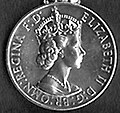History
The medal was established on 14 October 1914 as the third level decoration for gallantry in action for ratings of the Royal Navy, not at the standard required to receive the Victoria Cross or the Conspicuous Gallantry Medal. [3] The equivalent decoration for Officers and Warrant Officers was the Distinguished Service Cross (DSC). The DSM ranked below the DSC in order of precedence, between the George Medal and the Military Medal after those medals were established in 1940 and 1916 respectively. [1] Awards of the DSM were announced in the London Gazette. Recipients are entitled to use the post-nominal letters "DSM".
The DSM was intended to reward bravery at sea. For example, members of the Royal Naval Division, who served alongside the Army in France in the First World War, were eligible for Army decorations, including the Distinguished Conduct Medal and the Military Medal. [4]
From 1916, ribbon bars could be authorised for subsequent awards of the DSM. [5]
In 1940 the award was extended to Royal Air Force personnel serving with the Fleet and, in 1942, to members of the Merchant Navy, and Army personnel serving afloat, for example manning a merchant ship's anti-aircraft guns. [5] A number of awards were also made to civilians, including two for ferrying troops from the beaches during the 1940 Dunkirk evacuation. [6]
In 1979 eligibility for a number of awards, including the DSM, was extended to permit posthumous awards. [7] Until that time, only the Victoria Cross and a mention in dispatches could be awarded posthumously.
The Distinguished Service Medal was discontinued in 1993, as part of the review of the British honours system which recommended removing distinctions of rank in respect of awards for bravery. Since then the Distinguished Service Cross, previously only open to Commissioned and Warrant Officers, has been awarded to all ranks. [5]
The DSM had also been awarded by Commonwealth countries but by the 1990s most, including Canada, Australia and New Zealand, were establishing their own honours systems and no longer recommended British honours. [8]
This page is based on this
Wikipedia article Text is available under the
CC BY-SA 4.0 license; additional terms may apply.
Images, videos and audio are available under their respective licenses.






